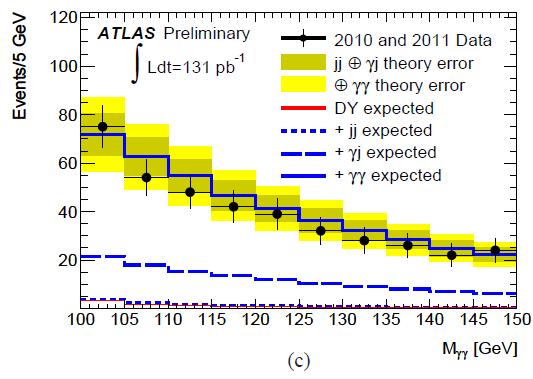In the paper they do not seem to mention the EHR at all. It is just as if they were working at all these nice analyses they are doing, and at one point they said, "Hey, why don't we put out a background study for Higgs searches in diphotons today ?" "Yeah, that'd be fun, let's do it" .
This strikes me as a bit odd -it looks like acting in denial, pretending, that is, that there was no leak, that nobody discussed their internal matters. Odd to the point that if it was a single person doing this we might dub as childish such behaviour. The thing is, wee may like the web or not (I love it), but we certainly cannot ignore its existence, lest we look like aliens. While a blog or two may be happily ignored by 3000-strong collaborations without anybody finding the thing weird in the slightest, the situation changes if the rumour of an internal 4-sigma signal by the experiment reaches the media around the world.
Anyway, let me comment briefly the information that ATLAS decided to publish. The document focuses on 2010 and 2011 data and describes the background sources to events with two photon candidates of high momentum. To the 38 inverse picobarns of good 2010 data, 94/pb are added for this study -thus almost doubling the statistics on which the EHR was originally based. Surely, if half the data showed a 4-sigma signal, one expects to see a Empire State Building-sized peak in the whole data, right ?
... Right. Unfortunately, that is not the case, but what's somewhat surprising is that the former peak at 115 GeV, obviously a fluctuation, is not just dampened by the added data, but actually it becomes a deficit!
Now, I cannot comment on that internal document of ATLAS -I am no New Scientist reporter- but what I can certainly say is that the data on which that alleged signal was based had been in large part already published by ATLAS, since it had been in a talk at the Moriond 2011 conference just a month before. And the Moriond plot did show some upward fluctuation at 115 GeV, although one completely in agreement with estimated backgrounds.
The added data have made the upward fluke a downward deficit. You can check it out in the figure below, or see the two twin figures in the paper. What is interesting is that ATLAS shows the 2011 data alone, as well as the 2011 data together with the 2010 data, but they do not show the bumpy 2010 data by themselves.

In maybe the only point where the ATLAS document seems to address the EHR, they clarify that a Higgs boson of 115 GeV would contribute to two adjoining bins in this distribution, given the known resolution on the diphoton invariant mass and a Higgs boson produced by standard means (that's a necessary specification to make, since a Higgs produced with large momentum by some exotic mechanism would give higher-energy photons and thus a different expected width of the reconstructed mass; but of course the events in this plot do not have the two photons with large boost).
In the end, what should we conclude from the ATLAS paper ? Nothing more than we already had -there is no 30-times-enhanced Higgs-like particle decaying to photon pairs in LHC data. Sorry, folks -the road to a deepening of our understanding of matter at the fundamental scale is still long and unfortunately bumpy -bumpy with the wrong kind of bumps, unfortunately.
UPDATE: on the matter Peter makes the same point I made above, in the very title of his post on the matter.
Lubos also discusses it shortly in his blog.
Philip Gibbs had also written a piece on the new ATLAS report, which I unfortunately overlooked. See here.



Comments